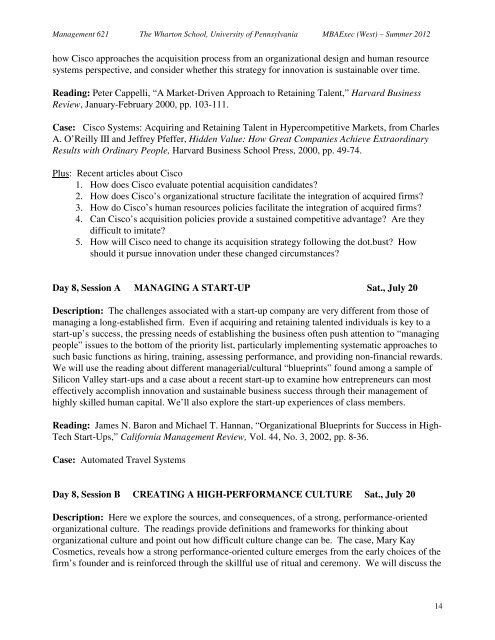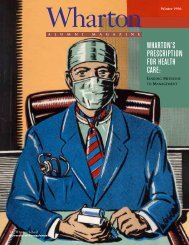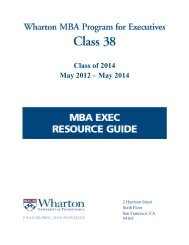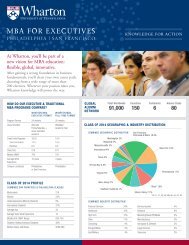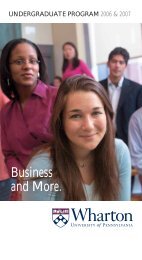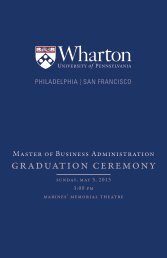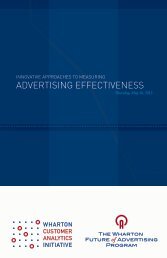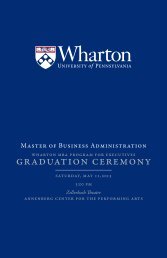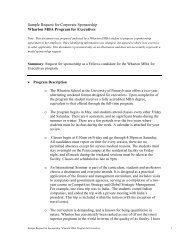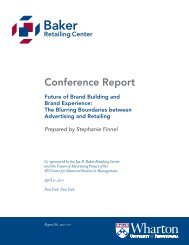version Date: April - The Wharton School of the University of ...
version Date: April - The Wharton School of the University of ...
version Date: April - The Wharton School of the University of ...
Create successful ePaper yourself
Turn your PDF publications into a flip-book with our unique Google optimized e-Paper software.
Management 621 <strong>The</strong> <strong>Wharton</strong> <strong>School</strong>, <strong>University</strong> <strong>of</strong> Pennsylvania MBAExec (West) – Summer 2012<br />
how Cisco approaches <strong>the</strong> acquisition process from an organizational design and human resource<br />
systems perspective, and consider whe<strong>the</strong>r this strategy for innovation is sustainable over time.<br />
Reading: Peter Cappelli, “A Market-Driven Approach to Retaining Talent,” Harvard Business<br />
Review, January-February 2000, pp. 103-111.<br />
Case: Cisco Systems: Acquiring and Retaining Talent in Hypercompetitive Markets, from Charles<br />
A. O’Reilly III and Jeffrey Pfeffer, Hidden Value: How Great Companies Achieve Extraordinary<br />
Results with Ordinary People, Harvard Business <strong>School</strong> Press, 2000, pp. 49-74.<br />
Plus: Recent articles about Cisco<br />
1. How does Cisco evaluate potential acquisition candidates<br />
2. How does Cisco’s organizational structure facilitate <strong>the</strong> integration <strong>of</strong> acquired firms<br />
3. How do Cisco’s human resources policies facilitate <strong>the</strong> integration <strong>of</strong> acquired firms<br />
4. Can Cisco’s acquisition policies provide a sustained competitive advantage Are <strong>the</strong>y<br />
difficult to imitate<br />
5. How will Cisco need to change its acquisition strategy following <strong>the</strong> dot.bust How<br />
should it pursue innovation under <strong>the</strong>se changed circumstances<br />
Day 8, Session A MANAGING A START-UP Sat., July 20<br />
Description: <strong>The</strong> challenges associated with a start-up company are very different from those <strong>of</strong><br />
managing a long-established firm. Even if acquiring and retaining talented individuals is key to a<br />
start-up’s success, <strong>the</strong> pressing needs <strong>of</strong> establishing <strong>the</strong> business <strong>of</strong>ten push attention to “managing<br />
people” issues to <strong>the</strong> bottom <strong>of</strong> <strong>the</strong> priority list, particularly implementing systematic approaches to<br />
such basic functions as hiring, training, assessing performance, and providing non-financial rewards.<br />
We will use <strong>the</strong> reading about different managerial/cultural “blueprints” found among a sample <strong>of</strong><br />
Silicon Valley start-ups and a case about a recent start-up to examine how entrepreneurs can most<br />
effectively accomplish innovation and sustainable business success through <strong>the</strong>ir management <strong>of</strong><br />
highly skilled human capital. We’ll also explore <strong>the</strong> start-up experiences <strong>of</strong> class members.<br />
Reading: James N. Baron and Michael T. Hannan, “Organizational Blueprints for Success in High-<br />
Tech Start-Ups,” California Management Review, Vol. 44, No. 3, 2002, pp. 8-36.<br />
Case: Automated Travel Systems<br />
Day 8, Session B CREATING A HIGH-PERFORMANCE CULTURE Sat., July 20<br />
Description: Here we explore <strong>the</strong> sources, and consequences, <strong>of</strong> a strong, performance-oriented<br />
organizational culture. <strong>The</strong> readings provide definitions and frameworks for thinking about<br />
organizational culture and point out how difficult culture change can be. <strong>The</strong> case, Mary Kay<br />
Cosmetics, reveals how a strong performance-oriented culture emerges from <strong>the</strong> early choices <strong>of</strong> <strong>the</strong><br />
firm’s founder and is reinforced through <strong>the</strong> skillful use <strong>of</strong> ritual and ceremony. We will discuss <strong>the</strong><br />
14


